Tanzania, located in East Africa, is renowned for its stunning landscapes, diverse wildlife, and rich cultural heritage. Home to iconic destinations such as Mount Kilimanjaro, the Serengeti National Park, and the Zanzibar Archipelago, Tanzania offers a wealth of experiences for travelers seeking adventure and exploration. The country is a melting pot of cultures, with over 120 ethnic groups contributing to its vibrant social fabric. Despite facing challenges in recent years, Tanzania remains a popular destination for tourists and adventurers alike.
Table of Contents
Geography
Tanzania covers an area of approximately 945,087 square kilometers, making it the largest country in East Africa. It is bordered by Kenya and Uganda to the north, Rwanda, Burundi, and the Democratic Republic of the Congo to the west, Zambia to the southwest, Malawi to the south, and Mozambique to the southeast. The Indian Ocean lies to the east, providing stunning coastlines and beautiful beaches.
The country’s diverse geography includes the vast plains of the Serengeti, the majestic Mount Kilimanjaro, and the pristine beaches of Zanzibar. Mount Kilimanjaro, standing at 5,895 meters, is the highest peak in Africa and a popular destination for trekkers from around the world. The Serengeti National Park is famous for its annual wildebeest migration, where millions of animals traverse the plains in search of greener pastures.
Tanzania’s climate varies by region, with coastal areas experiencing a tropical climate while the inland areas have a more temperate climate. The country has two main rainy seasons: the long rains from March to May and the short rains from October to December. This variation in climate supports a diverse range of ecosystems, from savannahs and forests to wetlands and coral reefs.
States of Tanzania
Tanzania is divided into 30 administrative regions; 25 regions on the mainland and 5 in Zanzibar. which serve as the highest administrative divisions in the country. These regions are not called states, but they function similarly in terms of governance.
| No. | Region |
|---|---|
| 1 | Arusha |
| 2 | Dar Es Salaam |
| 3 | Dodoma |
| 4 | Geita |
| 5 | Iringa |
| 6 | Kagera |
| 7 | Katavi |
| 8 | Kigoma |
| 9 | Kilimanjaro |
| 10 | Lindi |
| 11 | Manyara |
| 12 | Mara |
| 13 | Mbeya |
| 14 | Morogoro |
| 15 | Mtwara |
| 16 | Mwanza |
| 17 | Njombe |
| 18 | Pwani |
| 19 | Rukwa |
| 20 | Ruvuma |
| 21 | Shinyanga |
| 22 | Simiyu |
| 23 | Singida |
| 24 | Tabora |
| 25 | Tanga |
| 26 | Zanzibar |
| 27 | Pemba North |
| 28 | Pemba South |
| 29 | Unguja North |
| 30 | Unguja South |
History
Tanzania has a rich and complex history that dates back thousands of years. The region was home to ancient civilizations, including the Khoisan people and later the Bantu tribes, who migrated from West Africa. The coastal areas became important trading centers for merchants from Arabia, Persia, and India, leading to the establishment of city-states like Kilwa and Zanzibar.
In the 19th century, European powers began to colonize Africa, and Tanzania fell under German colonial rule in the late 1800s. Following World War I, the League of Nations mandated the territory to Britain, which governed it until Tanzania gained independence in 1961. The country became a republic in 1964 when the mainland (Tanganyika) and the islands of Zanzibar united.
After independence, Tanzania adopted a socialist model under the leadership of Julius Nyerere, who emphasized self-reliance and the promotion of African socialism. Despite initial successes, the country faced economic challenges and political unrest in the following decades. In the 1980s, Tanzania began implementing market-oriented reforms, leading to increased economic growth and development.
Today, Tanzania is known for its political stability, although challenges such as poverty, unemployment, and access to education and healthcare remain. The government continues to work towards improving the quality of life for its citizens while promoting tourism as a vital sector for economic growth.
Top Ten Must-Visit Destinations
1. Serengeti National Park
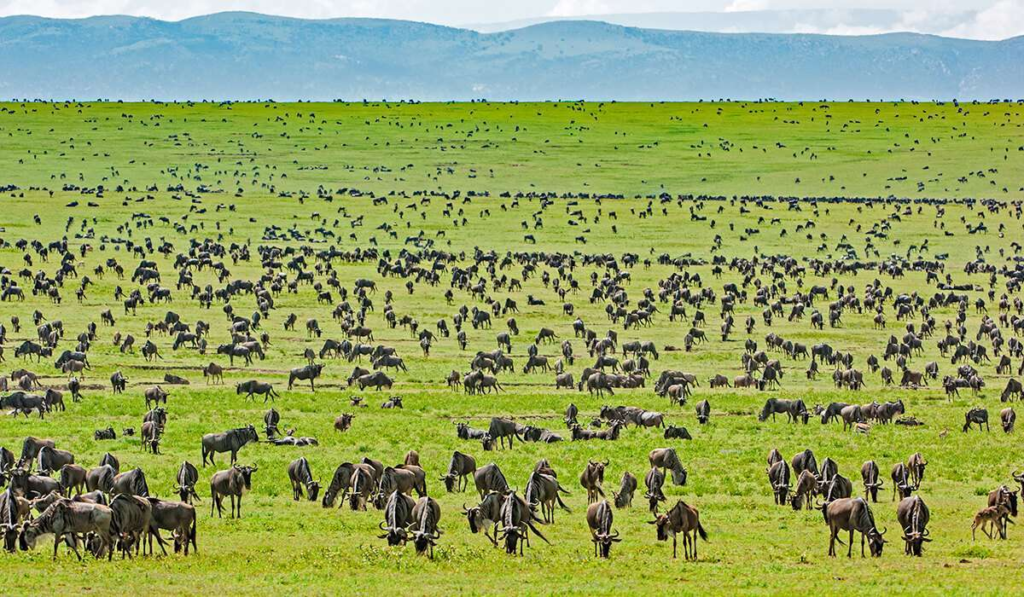
Serengeti National Park is one of the most famous wildlife reserves in the world, renowned for its vast savannahs and incredible biodiversity. The park is home to the “Big Five” (lion, leopard, elephant, buffalo, and rhinoceros) and hosts the annual wildebeest migration, where millions of wildebeest, zebras, and other herbivores travel in search of food and water. Visitors can embark on thrilling game drives, hot air balloon safaris, and guided walking tours to experience the stunning wildlife and breathtaking landscapes.
2. Mount Kilimanjaro

Mount Kilimanjaro, Africa’s highest peak, is a bucket-list destination for many adventurers and trekkers. Standing at 5,895 meters, Kilimanjaro attracts climbers from around the world, offering various routes to the summit, including the Marangu, Machame, and Lemosho routes. The trek takes climbers through diverse ecosystems, from lush rainforests to alpine deserts, culminating in breathtaking views from the summit. The sense of accomplishment and stunning vistas make this trek a memorable experience.
3. Zanzibar Archipelago

The Zanzibar Archipelago, located off the coast of Tanzania, is famous for its stunning beaches, crystal-clear waters, and rich history. Zanzibar City, the capital, is home to Stone Town, a UNESCO World Heritage Site known for its narrow alleys, vibrant markets, and historical buildings. Visitors can relax on pristine beaches, explore spice plantations, and learn about the island’s history as a significant trading hub. The unique blend of cultures, including African, Arab, and Indian influences, adds to Zanzibar’s allure.
4. Ngorongoro Crater
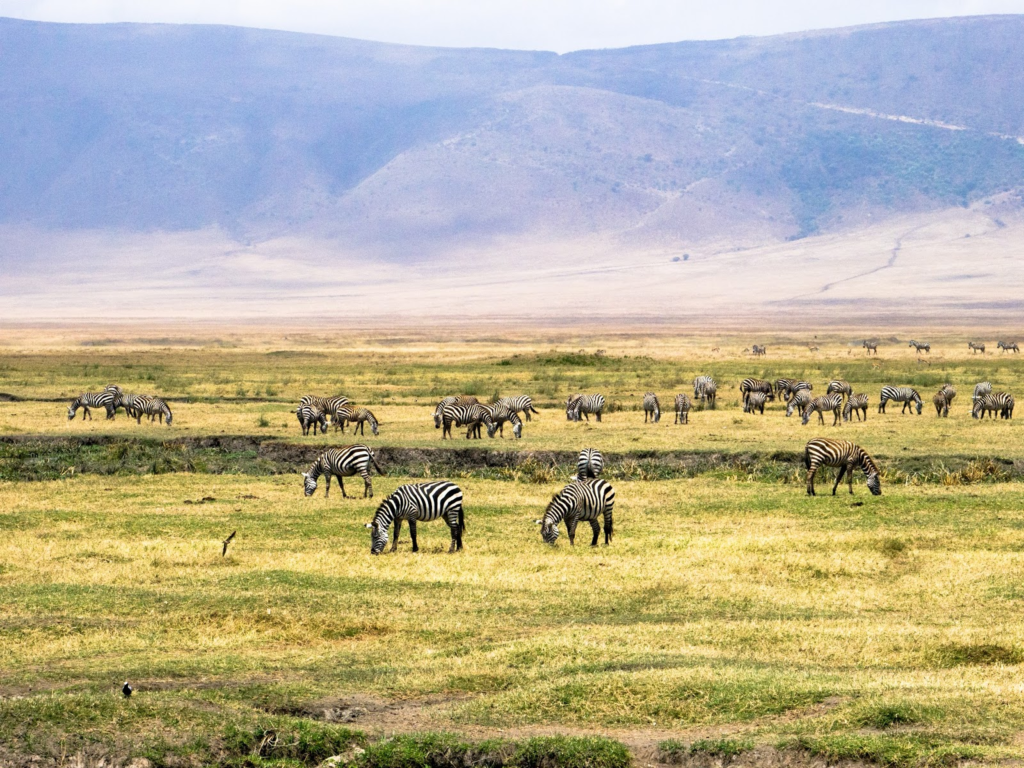
The Ngorongoro Crater is a UNESCO World Heritage Site and one of the most iconic wildlife conservation areas in Tanzania. Formed by a collapsed volcano, the crater is home to a diverse range of wildlife, including elephants, lions, and wildebeests. The fertile floor of the crater supports lush vegetation, making it an ideal habitat for animals. Visitors can take guided tours to explore the crater’s stunning landscapes and spot a variety of wildlife, creating an unforgettable safari experience.
5. Tarangire National Park

Tarangire National Park is known for its large herds of elephants and diverse wildlife. The park is characterized by its iconic baobab trees and scenic landscapes, making it a great destination for wildlife enthusiasts. Visitors can embark on game drives to spot elephants, lions, giraffes, and various bird species. The park’s proximity to the Serengeti and Ngorongoro Crater makes it an excellent addition to any safari itinerary.
6. Lake Victoria

Lake Victoria, one of the largest lakes in the world, is a significant geographical feature in Tanzania and offers unique cultural experiences. The lake is shared by Tanzania, Uganda, and Kenya and supports diverse ecosystems and communities. Visitors can explore the fishing villages along the shore, take boat trips to nearby islands, and enjoy fresh fish dishes. The lake is also a vital resource for local communities, providing livelihoods through fishing and agriculture.
7. Ruins of Kilwa Kisiwani

The Ruins of Kilwa Kisiwani, a UNESCO World Heritage Site, showcase the remnants of an ancient trading city that flourished in the 12th century. The site features impressive coral stone structures, including mosques and palaces, reflecting the architectural prowess of the time. Visitors can explore the ruins and learn about the history of Kilwa, which was once a prominent trading hub connecting Africa to the Arabian Peninsula and beyond.
8. Selous Game Reserve
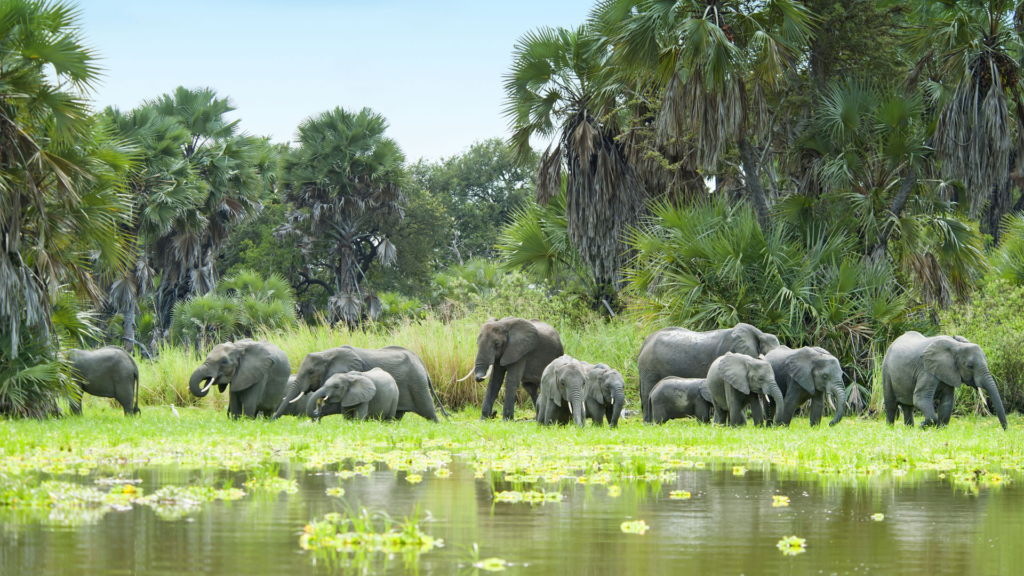
Selous Game Reserve, one of the largest wildlife reserves in Africa, offers a more remote and off-the-beaten-path safari experience. The reserve is home to a diverse range of wildlife, including elephants, hippos, and numerous bird species. Visitors can enjoy game drives, walking safaris, and boat safaris on the Rufiji River, allowing for unique wildlife encounters. The vastness of the reserve and its diverse ecosystems make it an excellent destination for nature lovers.
9. Arusha National Park

Arusha National Park is known for its stunning landscapes, including Mount Meru and the Ngurdoto Crater. The park offers opportunities for hiking, wildlife viewing, and birdwatching. Visitors can explore the lush forests and open grasslands, spot wildlife such as giraffes and buffalo, and enjoy panoramic views from various viewpoints. The park’s proximity to Mount Kilimanjaro makes it a popular starting point for trekkers and outdoor enthusiasts.
10. Mikumi National Park
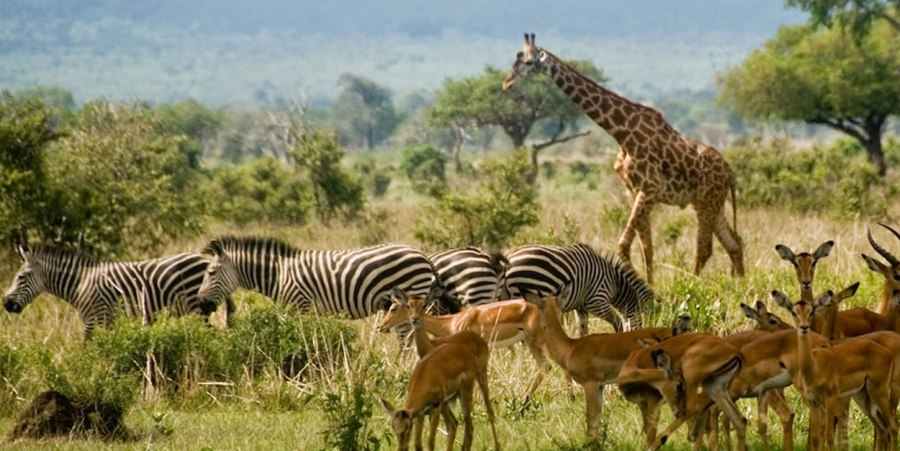
Mikumi National Park is often overshadowed by larger parks like Serengeti and Ngorongoro but offers excellent wildlife viewing opportunities. The park is home to elephants, lions, zebras, and various bird species, making it a great destination for safari enthusiasts. Visitors can embark on game drives to explore the park’s diverse ecosystems and enjoy the stunning landscapes. Mikumi’s accessibility from Dar es Salaam makes it a popular choice for short safaris.
Culture
Tanzania’s culture is a vibrant blend of influences from its diverse ethnic groups, Arab traders, and European colonizers. With over 120 ethnic groups, each with its own unique customs, languages, and traditions, Tanzania is a rich cultural tapestry. The Swahili language, which originated from a blend of Bantu languages and Arabic, is widely spoken and serves as a unifying factor among the different communities.
Traditional music and dance play a vital role in Tanzanian culture, with each ethnic group having its own distinctive styles. Music is often accompanied by traditional instruments such as drums, flutes, and stringed instruments, creating lively and rhythmic performances. Festivals and celebrations often feature traditional dance performances, showcasing the cultural heritage of the various communities.
Tanzania is also known for its vibrant arts and crafts scene, with local artisans creating beautiful textiles, wood carvings, and beadwork. Markets across the country are filled with colorful handicrafts, providing visitors with opportunities to purchase unique souvenirs while supporting local artisans.
Festivals
Festivals in Tanzania are lively celebrations that reflect the country’s rich cultural heritage. One of the most significant festivals is the Swahili Cultural Festival, celebrated in coastal towns such as Zanzibar. The festival showcases the diverse Swahili culture through music, dance, and culinary delights. Visitors can immerse themselves in the vibrant atmosphere, enjoy traditional performances, and savor local delicacies.
Another important celebration is the Nguvumali Festival, held in the Kilimanjaro region to celebrate the end of the harvest season. This festival includes traditional dances, music, and food, bringing together local communities to celebrate their agricultural achievements. The festival provides an opportunity for cultural exchange and strengthens community bonds.
Additionally, Eid al-Fitr and Eid al-Adha are celebrated by the Muslim population in Tanzania, marking the end of Ramadan and the annual pilgrimage to Mecca, respectively. These festivals involve communal prayers, feasting, and charitable giving, reinforcing the values of community and family.
Economy
Tanzania’s economy is primarily based on agriculture, which employs a significant portion of the population. The country is known for producing coffee, tea, tobacco, and various fruits and vegetables. Agriculture plays a crucial role in supporting local communities and providing food security.
Tourism is another vital sector in Tanzania’s economy, attracting millions of visitors each year to its national parks, wildlife reserves, and stunning beaches. The government actively promotes tourism as a means of generating revenue and creating jobs for local communities. The unique natural beauty and cultural richness of Tanzania make it a sought-after destination for adventure seekers and nature lovers.
In recent years, Tanzania has also sought to diversify its economy by investing in sectors such as mining and manufacturing. The country is rich in natural resources, including gold, diamonds, and natural gas, which present opportunities for economic growth. However, challenges such as infrastructure deficits and political stability must be addressed for sustainable development to be realized.
Cuisine
Tanzanian cuisine is a delightful fusion of flavors and ingredients influenced by various cultures. Staples include rice, maize, and cassava, often accompanied by a variety of meats, vegetables, and spices. One of the most popular dishes is “ugali,” a thick maize porridge that serves as a base for many meals. It is typically served with stews, grilled meats, or vegetables, and is a staple in Tanzanian households.
Fish is also a significant part of the diet, particularly in coastal areas and around Lake Victoria. Dishes such as “samosas” (fried or baked pastry filled with meat or vegetables) and “kebabs” are popular street foods enjoyed by locals and visitors alike. Spices such as turmeric, cumin, and coriander are commonly used to enhance the flavors of dishes.
Zanzibar, known as the “Spice Island,” is famous for its aromatic spices, including cloves, cardamom, and cinnamon. Visitors to Zanzibar can explore spice plantations and learn about the cultivation and uses of these spices, making it a unique culinary experience.
Top Eight Most Famous Food of Tanzania

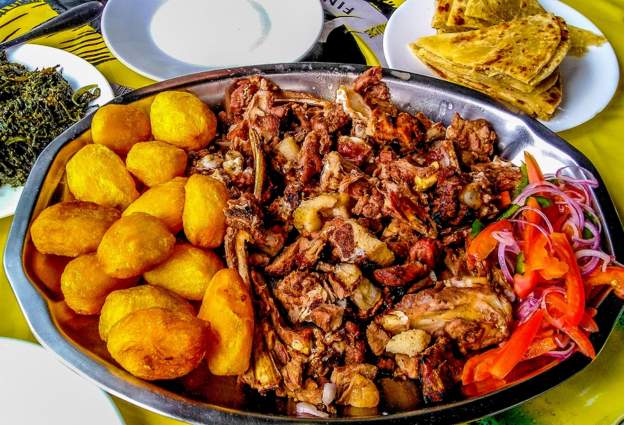






Interesting Facts
- Tanzania is home to Mount Kilimanjaro, the highest peak in Africa, attracting thousands of trekkers each year.
- The Serengeti National Park hosts the largest wildlife migration in the world, with millions of animals moving in search of greener pastures.
- Zanzibar, part of Tanzania, is known for its rich history as a trading hub and has a unique blend of African, Arab, and Indian influences.
- Tanzania has over 120 ethnic groups, each contributing to the country’s cultural diversity and heritage.
- Lake Victoria, shared by Tanzania, Uganda, and Kenya, is the largest lake in Africa and a vital resource for local communities.
- The Ngorongoro Crater is one of the most well-preserved volcanic calderas in the world and a UNESCO World Heritage Site.
- Tanzania’s economy relies heavily on agriculture, which employs approximately 75% of the population.
- The country is home to some of the oldest archaeological sites in the world, including Olduvai Gorge, which is considered the “Cradle of Mankind.”
- Swahili, the official language, is spoken by millions across East Africa and serves as a unifying language for diverse ethnic groups.
- Tanzania is a popular destination for eco-tourism, with various national parks and reserves focused on conservation and wildlife protection.
Conclusion
Tanzania is a land of breathtaking landscapes, rich cultural heritage, and diverse wildlife. From the majestic peaks of Mount Kilimanjaro to the vibrant markets of Zanzibar, the country offers a wealth of experiences for travelers. Its diverse cultures, vibrant festivals, and delicious cuisine make Tanzania a fascinating destination to explore. As the country continues to develop and promote tourism, it remains a place of natural beauty and cultural richness, inviting adventurers and nature enthusiasts to discover its wonders.

